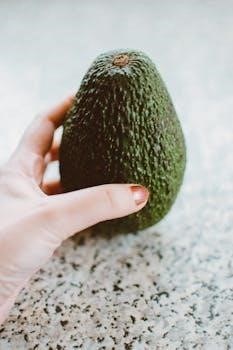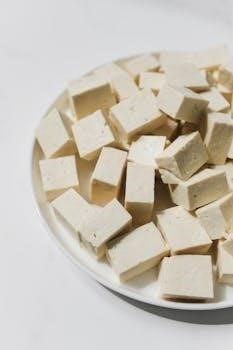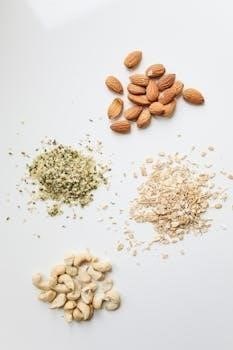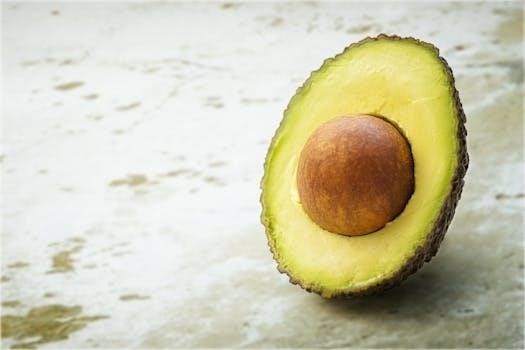Low-Fat Diet⁚ An Overview
A low-fat diet involves limiting fat intake to less than 30% of total daily calories. This approach aims to promote weight management, improve heart health, and manage cholesterol levels by reducing unhealthy fat consumption.

Defining a Low-Fat Diet
A low-fat diet is characterized by a daily fat intake that constitutes less than 30% of total caloric consumption. This typically involves prioritizing lean proteins, fruits, vegetables, and low-fat dairy options.
Percentage of Calories from Fat
The cornerstone of a low-fat diet lies in restricting the proportion of daily calories derived from fat sources. Typically, this entails limiting fat intake to below 30% of the total calories consumed each day. For instance, if an individual consumes 2000 calories daily, their fat intake should ideally remain under 600 calories, which translates to approximately 67 grams of fat. This percentage can vary depending on individual health goals and specific dietary guidelines. Some very low-fat diets may even restrict fat intake to below 10% of total calories, although such restrictive approaches should be undertaken with careful monitoring and professional guidance to avoid nutritional deficiencies. It’s crucial to consider the types of fats consumed, prioritizing unsaturated fats over saturated and trans fats.

Foods to Include in a Low-Fat Diet
A low-fat diet emphasizes foods naturally low in fat, such as fruits, vegetables, lean proteins like fish and poultry, and low-fat dairy alternatives to support overall health.
Fruits and Vegetables
Fruits and vegetables are cornerstones of a low-fat diet, offering essential vitamins, minerals, and fiber while being naturally low in fat. Incorporating a wide variety ensures a diverse nutrient intake, supporting overall health and well-being. These foods also contribute to satiety, aiding in weight management. Aim for at least four servings daily, choosing colorful options like berries, leafy greens, and citrus fruits. Enjoy them fresh, frozen, or lightly steamed, avoiding added fats or sugars. Remember that dark green and yellow fruits and vegetables are a good source of Vitamin A.
Lean Proteins
Lean proteins are crucial for maintaining muscle mass and supporting metabolic function in a low-fat diet. Opt for sources like skinless chicken breast, turkey, fish, beans, lentils, and egg whites. These options provide essential amino acids without excessive saturated fats. Trim visible fat from meats before cooking, and choose low-fat cooking methods like grilling, baking, or poaching. Seafood is also a great option because it is low in fat. Incorporating lean protein into each meal helps promote satiety and stabilize blood sugar levels, further aiding in weight management and overall health.
Low-Fat Dairy Alternatives
For those following a low-fat diet, dairy alternatives are excellent for reducing saturated fat intake while still enjoying creamy textures and essential nutrients. Opt for unsweetened almond milk, soy milk, or rice milk, which are lower in fat and calories compared to whole milk. Low-fat yogurt is another good option. These alternatives can be used in smoothies, cereals, and cooking. Fortified versions often provide calcium and vitamin D, which are important for bone health. Choose options without added sugars to further minimize caloric intake and support your low-fat dietary goals effectively.
Foods to Limit or Avoid
When following a low-fat diet, it’s crucial to limit or avoid foods high in saturated and trans fats. These include fatty meats, full-fat dairy, fried foods, and processed snacks.
Saturated Fats
Saturated fats are solid at room temperature and, while not inherently unhealthy in moderation, excess consumption can lead to potential health problems. Limit saturated fat intake to less than 7% of your total daily calories. Common sources include fatty meats like bacon, sausage, and ribs, as well as full-fat dairy products like cheese and butter. Avoid organ meats, including liver. It is important to choose lean protein options and low-fat dairy alternatives to minimize saturated fat consumption and support cardiovascular health. Reading food labels is essential to identify and limit these fats.
Trans Fats
Trans fats are unhealthy fats that should be eliminated from the diet as much as possible. These fats can negatively impact cholesterol levels, increasing LDL (bad) cholesterol and decreasing HDL (good) cholesterol, thus raising the risk of heart disease. Common sources of trans fats include fried foods, processed snacks, and some commercially baked goods. Always check food labels for partially hydrogenated oils, which indicate the presence of trans fats. Choosing trans-fat-free margarine-like spreads and avoiding fried foods are important steps in reducing trans fat intake and promoting better cardiovascular health.
High-Fat Meats and Dairy
High-fat meats and dairy products should be limited or avoided on a low-fat diet due to their high saturated fat content. These foods can contribute to elevated LDL cholesterol levels, increasing the risk of heart disease. Examples include bacon, sausage, franks, ribs, and organ meats like liver, along with full-fat milk, yogurt, and cheese. Opt for leaner protein sources such as skinless chicken or turkey breast, fish, or plant-based options like beans and lentils. Choose nonfat or low-fat dairy alternatives to help reduce overall fat intake while still obtaining essential nutrients.
Potential Benefits of a Low-Fat Diet
Adopting a low-fat diet can offer benefits such as supporting weight management and improving heart health by reducing unhealthy cholesterol levels. Always consult healthcare providers for specific guidance.
Weight Management
Low-fat diets are often pursued for weight management, based on the idea that dietary fat, being the most energy-dense macronutrient, contributes to excess weight gain. By limiting fat intake to less than 30% of total daily calories, individuals aim to reduce overall calorie consumption.
Plant-based, low-fat diets are generally high in fiber and low in fat, resulting in lower energy density, which can aid in weight control. Choosing low-fat foods and utilizing low-fat cooking methods can also support weight loss and maintenance. However, it’s important to maintain a balanced approach.
Heart Health
Adopting a low-fat diet is a positive step toward promoting heart health by managing cholesterol levels. Unhealthy cholesterol levels, particularly LDL, increase the risk of heart disease; limiting saturated fat to less than 7% of daily calories can help lower LDL.
AHA strongly endorses a diet rich in fruits, vegetables, low-fat dairy, lean protein, and whole grains. Choosing healthier fats, such as those from olive and canola oil, while limiting saturated fats in meats and cheeses, further contributes to cardiovascular well-being. This can help decrease cardiovascular morbidity and mortality.

Potential Risks and Considerations
Very low-fat diets can lead to vitamin and mineral deficiencies, impacting overall health. It’s crucial to maintain a balanced diet that includes beneficial fats from fish, avocado, and seeds for longevity.
Vitamin and Mineral Deficiencies
Restrictive low-fat diets can inadvertently lead to deficiencies in essential vitamins and minerals. When fat intake is drastically reduced, the absorption of fat-soluble vitamins (A, D, E, and K) may be compromised, potentially affecting bone health, immune function, and overall well-being. Furthermore, limiting a wide variety of foods to adhere to strict low-fat guidelines can result in inadequate intake of other crucial nutrients. It is essential to prioritize nutrient-dense foods and consider supplementation, under the guidance of a healthcare provider or registered dietitian, to mitigate the risk of deficiencies while following a low-fat dietary approach, ensuring optimal health and nutritional balance.
Impact on HDL Cholesterol
While low-fat diets are often recommended for cardiovascular health, it’s crucial to consider their potential impact on high-density lipoprotein (HDL) cholesterol levels. Some studies indicate that very low-fat diets may inadvertently lower HDL cholesterol, often referred to as “good” cholesterol, which plays a protective role against heart disease. This reduction in HDL could potentially offset some of the benefits gained from lowering overall cholesterol. Therefore, it is essential to focus on consuming healthy fats, such as those found in avocados, nuts, and olive oil, which can help maintain or even increase HDL levels, contributing to a more favorable lipid profile and overall cardiovascular well-being.

Debate on Low-Fat vs. Low-Carb Diets
The debate continues regarding whether low-fat or low-carb diets are superior for weight management, cardiovascular health, and metabolic well-being. Each approach has potential benefits and drawbacks that warrant careful consideration and personalized dietary strategies.
Comparison of Effects on Weight and Cholesterol
Studies comparing low-fat and low-carb diets often assess their impact on weight and cholesterol levels. Low-fat diets may effectively reduce overall calorie intake, aiding in weight loss, but can sometimes lower beneficial HDL cholesterol. Conversely, low-carb diets may lead to initial rapid weight loss and improved triglyceride levels, but concerns exist regarding long-term sustainability and potential increases in LDL cholesterol. Individual responses vary, highlighting the importance of personalized dietary approaches. Research suggests neither is universally superior. Factors such as genetics, activity level, and overall dietary adherence influence outcomes, necessitating consultation with healthcare professionals for informed decisions.
Practical Tips for Following a Low-Fat Diet
To effectively follow a low-fat diet, prioritize reading food labels carefully. Also, adopt low-fat cooking methods like grilling, baking, or poaching to minimize added fats during meal preparation.
Reading Food Labels
When following a low-fat diet, mastering the art of reading food labels is crucial for making informed choices. Begin by examining the “Total Fat” content per serving. Aim for products where fat contributes a smaller percentage of the total calories. A general rule of thumb is that if a food provides 100 calories and has 3 grams of fat or less, it can be considered a low-fat option. Pay close attention to the “Saturated Fat” and “Trans Fat” sections, as these are the fats you want to minimize or avoid altogether.
Furthermore, be mindful of serving sizes. The nutritional information listed on the label is based on the stated serving size, so adjust your calculations accordingly. Scrutinize the ingredient list for hidden sources of fat, such as oils, butter, or cream.
Low-Fat Cooking Methods
Adopting low-fat cooking methods is essential for maintaining a low-fat diet while still enjoying delicious meals. Instead of frying, opt for baking, grilling, poaching, or steaming. These techniques minimize the need for added fats and preserve the natural flavors of the ingredients. When roasting meats, trim visible fat before cooking and remove the skin from poultry. Use non-stick cookware to reduce the amount of oil needed.
For sautéing, use small amounts of vegetable broth, water, or cooking spray instead of oil. When preparing sauces and dressings, use low-fat or fat-free ingredients. Experiment with herbs, spices, and citrus juices to enhance flavor without relying on fats. Embrace techniques like stir-frying with minimal oil and using marinades to tenderize meats.




